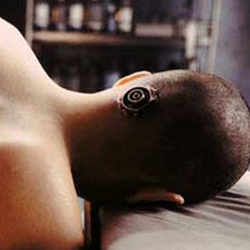(→Enhancement Cybernetics) |
|||
| Line 15: | Line 15: | ||
==Enhancement Cybernetics== | ==Enhancement Cybernetics== | ||
| − | [[image:Datajack.jpg|An image of | + | [[image:Datajack.jpg|An image of an early version of the Datajack, which allows users to literally 'plug in' to their computers.|thumb]] |
While not as popular as restorative cybernetics, due to the innate dangers that come with cybernetic implantation, cybernetics designed for enhancement are by no means rare or unheard of. The most common variety of enhancement cybernetic is the [[Datajack]], which is a direct implantation on the brain itself. The [[Neurojack]] is also a common enhancement cybernetic. The other kind of common 'enhancement' cybernetic is the enhanced cybernetic limb. | While not as popular as restorative cybernetics, due to the innate dangers that come with cybernetic implantation, cybernetics designed for enhancement are by no means rare or unheard of. The most common variety of enhancement cybernetic is the [[Datajack]], which is a direct implantation on the brain itself. The [[Neurojack]] is also a common enhancement cybernetic. The other kind of common 'enhancement' cybernetic is the enhanced cybernetic limb. | ||
Latest revision as of 00:44, 22 September 2011
Cybernetics is a general catch-all term to describe the use of electronic and computer technology to either enhance or restore a body to its natural usefulness. Due to this fact, cybernetics are often classified into two purposes: Restorative and Enhancing.
Restorative Cybernetics
Restorative cybernetics are the better known and more widely accessible segment of the cybernetics industry. Often this is seen in the form of artificial arms and legs that act very much like the real thing. Most of these models are able to replicate all the major functions of the original limb, such as typing with a hand for an artificial arm or being able to walk with an artificial leg.
Models
At the low end of the restorative cybernetics hierarchy are prosthetic limbs, which technically are not cybernetics at all. Instead of relying on electronics and computer technology, they rely on the motion of limb parts that do remain. These are most effective with legs that need replaced and there is a suitable part of the upper leg remaining. This simplicity allows for low expense replacements that are still functional to be produced, even if the functionality is less than ideal. These can often be found for only a few thousand credits.
A rank above non-cybernetic prosthetic come basic cybernetic limbs. While these do have some electronic components, they do not offer full functions, or may be specialized at one specific task. An example would be an arm able to lift as a natural arm would, but unable to type effectively. Most of these start in the price range of 10,000 credits.
Standard cybernetic limbs are the most common. These have full functionality and look like a genuine arm. They can do almost any normal task as well as a natural limb could, from typing a report on a computer to lifting a box to pulling the trigger of a gun. These limbs average in cost at approximately 20,000 credits.
Beyond the standard cybernetic limb, there are a variety of additions or customizations that can be made to the arm. Many of these require a complete reworking of the arm, and are not available as additions to a standard limb. Examples of enhancements available include: EMP shielding, extra nimbleness (for cybernetic hands to type more effectively), extra strength, more 'natural' appearing. These enhancements, due to requiring the custom production or modification of an existing cybernetic, often make the costs much more expensive. Often the costs may start at over 100,000 credits. This is since each one of these cybernetics must be crafted individually, or at least heavily modified.
Enhancement Cybernetics
While not as popular as restorative cybernetics, due to the innate dangers that come with cybernetic implantation, cybernetics designed for enhancement are by no means rare or unheard of. The most common variety of enhancement cybernetic is the Datajack, which is a direct implantation on the brain itself. The Neurojack is also a common enhancement cybernetic. The other kind of common 'enhancement' cybernetic is the enhanced cybernetic limb.
Less common, much more dangerous, but possible are neurally grafted cybernetics to the brain itself. These are similar to the datajack and neurojack, but serve to be only accessed by the person the device is installed in, rather than external use. These kinds of procedures are prohibitively expensive and are often used as a last resort, since the success rates of these operations are much lower than alternative treatments.
As with most enhancement cybernetics, the cost for these exceeds the costs of standard restorative cybernetics.

